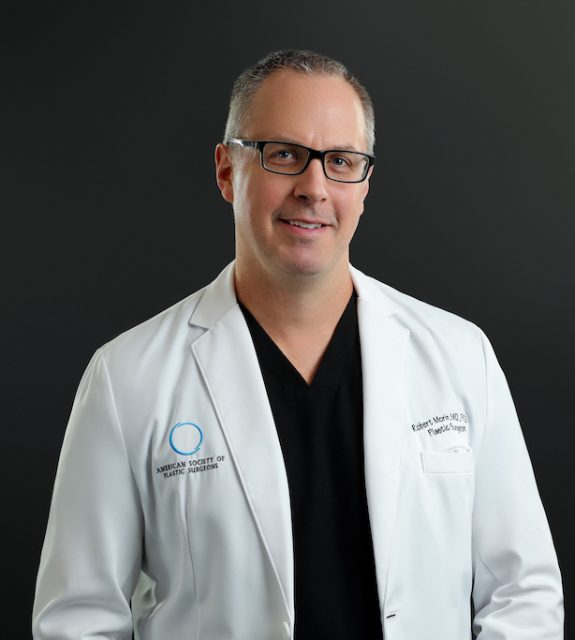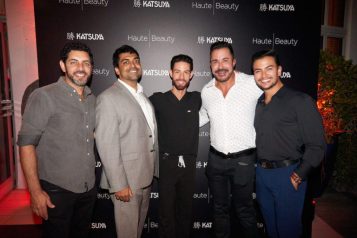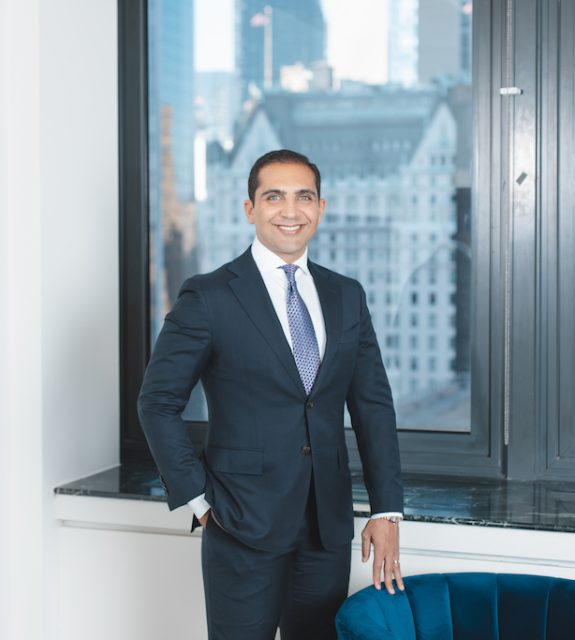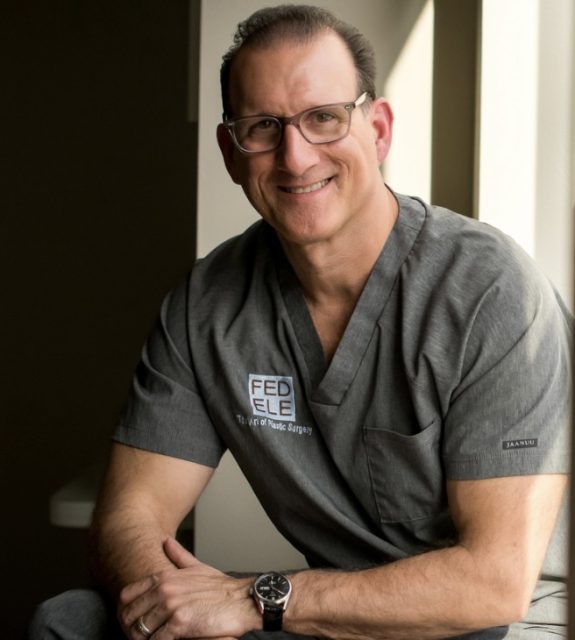Robert Morin, MD is a board-certified Plastic Surgeon, Craniofacial Surgeon, and Pediatric Plastic Surgeon specializing in reconstructive and cosmetic surgery involving the face and body. From a reconstructive perspective, Dr. Morin has extensive experience and expertise in the surgical treatment of patients with craniosynostosis, microtia, cleft lip and palate, and congenital and acquired deformities involving the face, ears, and nose. Dr. Morin is also an expert at reconstructing the face and skull in the setting of trauma, cancer, and other complex congenital malformations. Dr. Morin’s passion for reconstructing the faces of children led him to co-found a 501c3 charity named Developing Faces. The charity’s mission is to provide high-quality surgical care to babies and children with facial abnormalities living in developing countries around the world.
Here, he shares with Haute Beauty the mission of his practice and what new services he is excited to offer.
Was there a personal and/or professional experience that inspired you to open your practice?
Many experiences shaped my desire to become a plastic surgeon however one experience in medical school sparked my passion for reconstructing the face. I was on a plastic surgery rotation at a hospital in New York City in my 4th year of medical school when a teenage girl was brought to the emergency department following a car crash that severely injured her face. During my one-month rotation, I participated in 6 complex reconstructive surgeries to repair her fractured facial bones and replace her damaged soft tissue and skin. I was fascinated by the surgical team’s ability to restore what trauma had taken away. It was at that point that I decided to complete a Craniofacial and Pediatric Plastic Surgery fellowship and focus my career on reconstructing and enhancing the face.
What was your mission at the start of opening your practice? Has it changed?
My mission when I first started my practice was to provide the highest quality Plastic Surgery, Craniofacial Surgery, and Pediatric Plastic Surgery care possible. My number one passion has always been reconstructing the faces of children and my goal was to make that a significant part of my practice. I’m fortunate that during the last 14 years, I have developed a reputation for being an expert at complex facial surgery. In any given week I will repair a cleft lip, remodel a congenitally deformed skull, and perform several complex rhinoplasty surgeries. My mission today is exactly the same as it was 14 years ago and I love what I do.
If you had to pick three words to describe the vibe of your practice, what would they be and why?
Professional, honest, expert.
How did you come up with the name of your practice?
I completed my Craniofacial and Pediatric Plastic Surgery fellowship at Miami Children’s Hospital in Miami, Florida and I fell in love with the city. I therefore decided that I would like to one day practice in two locations: New York City and Miami. Although I lived in NYC for almost 20 years, I subsequently moved to New Jersey. In addition, I am definitely an East Coast type of person: open, direct, and honest. As a result, I decided that East Coast Aesthetic Surgery incorporated the locations I love, my personality, and the concept that all plastic surgery operations are judged by their aesthetic result.
What are the most popular services requested?
As an expert in rhinoplasty and craniofacial surgery, the most common procedures I am asked to perform involve the nose, face, and skull. Approximately 50 percent of my practice is dedicated to rhinoplasty and I have become both a leader and educator in that field. I use a combination of advanced surgical techniques in order to aesthetically enhance the nose in primary rhinoplasty and reconstruct the nose in the setting of revision rhinoplasty, nasal trauma, and complex craniofacial abnormalities. I also work closely with pediatric neurosurgeons and I am frequently asked to help reconstruct the faces and skulls of infants in the setting of craniosynostosis and other complicated congenital deformities.
What is the future of your field?
The future of the field of Plastic Surgery and Craniofacial Surgery is extremely bright. The increased use of video communication, cell phone cameras, and social media platforms, in addition to the growing acceptance of gender affirmation and facial feminization surgery, will continue to increase the demand for high-quality surgical results involving the reconstruction and aesthetic enhancement of the face. It is important to remember that all surgeons are not equal. I am fortunate to have completed a Craniofacial Fellowship with one of the most famous craniofacial surgeons of all time. That experience, combined with my passion, surgical experience, and expertise in the field of rhinoplasty, has allowed me to become an expert and a world leader in rhinoplasty, facial reconstruction, and facial feminization.
What are you best known for?
I am best known for Rhinoplasty, Craniofacial Surgery, and Facial Feminization. I completed a Craniofacial and Pediatric Plastic Surgery fellowship following my Plastic Surgery residency. As a result, I am an expert at all things involving the face and skull. I have evolved far beyond what I was taught in my training in the field of rhinoplasty and I perform complex rhinoplasty procedures that few plastic surgeons are comfortable performing. This expertise has also made me an expert at male-to-female transgender facial feminization surgery (FFS).
What is unique about your practice?
The most unique aspect of my practice is my passion, expertise, and dedication to the reconstruction and enhancement of the face. By completing a Craniofacial Fellowship, I was taught how to perform complex surgical procedures involving the facial bones, that few surgeons in the world are comfortable performing. These procedures include the cutting, advancing, and securing of the chin bone in the setting of a small chin. Another example includes the cutting and contouring of the forehead bone in order to feminize the face.
A second unique aspect of my practice is the exceptionally high quality of surgical care that all of my patients receive. In this age of consolidation and economies of scale in the world of healthcare, my number one priority is the patient. As an independent private practice physician, I am able to maintain a level of professionalism, customer service, and exceptional results that is difficult to find elsewhere. From the first phone call when a live human answers the telephone to the phone call from me the night of surgery, my patients always receive the attention, care, and expertise that they deserve.
Are there any new services you are excited to offer?
Although it is not new, the procedure I am currently most excited about in my practice is my advanced technique for male-to-female transgender feminizing rhinoplasty. My rhinoplasty expertise has evolved significantly over the last 14 years and I am extraordinarily happy with the results of my male-to-female transgender feminizing rhinoplasty. It is extremely difficult to transform a large masculine nose into a small feminine nose. By combining multiple advanced surgical techniques that remove, replace, and reshape the nasal bones and cartilage, I have created a set of procedures that are capable of beautifully feminizing a masculine nose. As a result, I am extraordinarily happy with the results that I am able to obtain for my transitioning patients.
From a body perspective, I’m excited to offer Emsculpt, in combination with either liposuction of the abdomen or abdominoplasty. Emsculpt is a noninvasive device that builds muscle, removes fat, and sculpts the body. By adding this powerful technology to either liposuction or tummy tuck, I have found that my abdominal contouring results have become truly incredible.
What is one underrated service that doesn’t receive as much press as it should be?
The most underrated service that I provide is the reconstruction of a child’s face in the setting of a giant congenital nevus. Children are sometimes born with large pigmented skin lesions that involve parts of their body and face. When these lesions involve the face, it can be especially devastating for both the child and their family. Fortunately, there are many successful reconstructive surgical procedures that I perform in order to remove the pigmented skin lesion and reconstruct the missing skin. As a Pediatric Plastic Surgery and Craniofacial Surgery expert, I am an expert in all of these procedures. The procedures I most commonly perform in order to reconstruct a child’s face following the removal of a giant congenital nevus include skin grafting, serial excision, regional flaps, and the use of tissue expansion. The results of these procedures are incredible, and they have an extremely positive impact on a child’s self-esteem, and overall ability to succeed in life.
For more information, visit Robert Morin, MD's social media:























